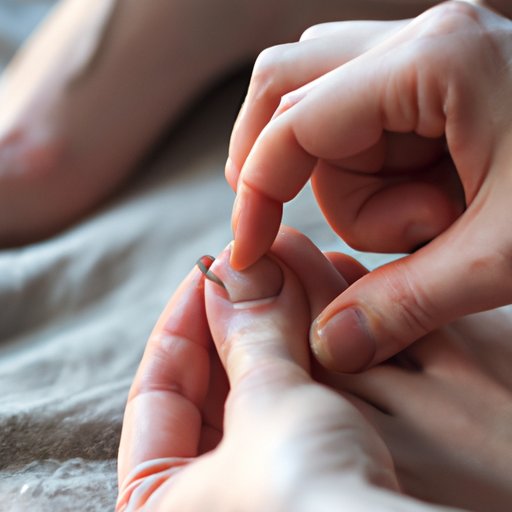I. Introduction
Ingrown toenails can be a painful and uncomfortable condition that affects millions of people worldwide. When the nail grows into the skin of the toe, it can cause inflammation, redness, and even infection. It is essential to prevent ingrown toenails by following some easy-to-follow preventive measures.
II. Anatomy of ingrown toenails
When nails grow, they curve downward and away from the skin. However, tight shoes, improper nail trimming, or injury can cause the nail’s edge to penetrate into the skin, causing pain, redness, and swelling. Moreover, people with diabetes, vascular disease, or other health conditions that affect blood flow to the feet are more prone to develop ingrown toenails.
III. Symptoms of ingrown toenails
The common symptoms of ingrown toenails include pain, tenderness, redness, and swelling around the nail. Moreover, when the toe becomes infected, it may develop pus, become warm to the touch, and emit an unpleasant odor. If left untreated, ingrown toenails can develop into a severe infection that may require medical attention.
IV. Ways to prevent ingrown toenails
To prevent ingrown toenails, you can follow these tips:
- Wearing properly fitted shoes that allow enough room for your toes to wiggle. Avoid tight shoes that compress your toes.
- Trimming nails straight across instead of rounding them off. Avoid cutting your nails too short, as this may also increase the risk of ingrown toenails.
- Avoiding tight socks or hosiery that put pressure on your toes and nails.
- Keeping your feet clean and dry by changing your socks frequently, or using foot powder to absorb moisture.
Following these practical tips can help you reduce the chances of developing ingrown toenails.
V. Home remedies for treating mild cases of ingrown toenails
If you notice an early sign of ingrown toenails, you can try managing it with these home remedies:
- Soaking your feet in warm water with Epsom salt or apple cider vinegar for 15-20 minutes, three times a day. This helps reduce inflammation and prevent infection.
- Applying an antibiotic cream over the affected area to fight off any bacteria that may cause an infection.
- Using a toenail file to gently smooth the nail’s edge, making sure not to cut the surrounding skin.
VI. When to seek medical attention
If your ingrown toenail is causing severe pain, swelling, and redness, it is time to seek medical attention. Doctors may recommend one of the following procedures:
- Lifting the edge of the nail and placing cotton or waxed dental floss under it to help the nail grow above the skin.
- Trimming or removing the nail’s edge if symptoms persist or there is a risk of developing an infection.
- In severe cases, doctors may recommend partial or total nail removal, especially in people with underlying health conditions that increase the risk of complications.
It is essential to follow your doctor’s advice to prevent complications and promote faster healing.
VII. Conclusion
Ingrown toenails may seem like a small problem, but they can cause severe discomfort and pain if left unattended. The best way to prevent ingrown toenails is by following simple preventive measures, like wearing properly fitted shoes, trimming your nails straight across, avoiding tight socks or hosiery, and keeping your feet clean and dry. However, if you find yourself dealing with a severe case of ingrown toenails, seek medical attention to prevent further complications.
Remember to take good care of your feet to stay healthy and pain-free.
